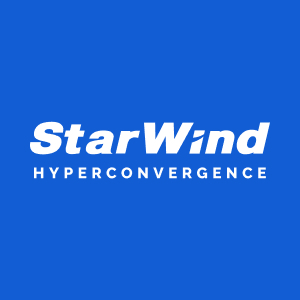Related Research Articles

VMware, Inc. is an American cloud computing and virtualization technology company with headquarters in Palo Alto, California. VMware was the first commercially successful company to virtualize the x86 architecture.
The Write Anywhere File Layout (WAFL) is a proprietary file system that supports large, high-performance RAID arrays, quick restarts without lengthy consistency checks in the event of a crash or power failure, and growing the filesystems size quickly. It was designed by NetApp for use in its storage appliances like NetApp FAS, AFF, Cloud Volumes ONTAP and ONTAP Select.
Platform virtualization software, specifically emulators and hypervisors, are software packages that emulate the whole physical computer machine, often providing multiple virtual machines on one physical platform. The table below compares basic information about platform virtualization hypervisors.
A virtual storage area network is a logical representation of a physical storage area network (SAN). A VSAN abstracts the storage-related operations from the physical storage layer, and provides shared storage access to the applications and virtual machines by combining the servers' local storage over a network into a single or multiple storage pools.
IBM Spectrum Protect is a data protection platform that gives enterprises a single point of control and administration for backup and recovery. It is the flagship product in the IBM Spectrum Protect family.
GPFS is high-performance clustered file system software developed by IBM. It can be deployed in shared-disk or shared-nothing distributed parallel modes, or a combination of these. It is used by many of the world's largest commercial companies, as well as some of the supercomputers on the Top 500 List. For example, it is the filesystem of the Summit at Oak Ridge National Laboratory which was the #1 fastest supercomputer in the world in the November 2019 TOP500 list of supercomputers. Summit is a 200 Petaflops system composed of more than 9,000 POWER9 processors and 27,000 NVIDIA Volta GPUs. The storage filesystem called Alpine has 250 PB of storage using Spectrum Scale on IBM ESS storage hardware, capable of approximately 2.5TB/s of sequential I/O and 2.2TB/s of random I/O.
The following tables compare general and technical information for a number of file systems.

VMware ESXi is an enterprise-class, type-1 hypervisor developed by VMware for deploying and serving virtual computers. As a type-1 hypervisor, ESXi is not a software application that is installed on an operating system (OS); instead, it includes and integrates vital OS components, such as a kernel.
VMware Infrastructure is a collection of virtualization products from VMware. Virtualization is an abstraction layer that decouples hardware from operating systems. The VMware Infrastructure suite allows enterprises to optimize and manage their IT infrastructure through virtualization as an integrated offering. The core product families are vSphere, vSAN and NSX for on-premises virtualization. VMware Cloud Foundation (VCF) is an infrastructure platform for hybrid cloud management. The VMware Infrastructure suite is designed to span a large range of deployment types to provide maximum flexibility and scalability.
VHD and its successor VHDX are file formats representing a virtual hard disk drive (HDD). They may contain what is found on a physical HDD, such as disk partitions and a file system, which in turn can contain files and folders. They are typically used as the hard disk of a virtual machine, are built into modern versions of Windows, and are the native file format for Microsoft's hypervisor, Hyper-V.
Pano Logic was a manufacturer of devices which present virtual desktops to the end user with no local processing power. They describe this concept as "zero client". This is perceived as offering benefits in end-user support and in power provision to desks. OEM versions have been included in displays from some vendors, allowing a single unit to be deployed. The company failed in October 2012. In March 2013, Propalms announced they had acquired the rights to support Panologic customers, and will "help transition the customer base to a new platform".
VMDK is a file format that describes containers for virtual hard disk drives to be used in virtual machines like VMware Workstation or VirtualBox.

VMware vSphere is VMware's cloud computing virtualization platform.

Universal Storage Platform (USP) was the brand name for an Hitachi Data Systems line of computer data storage disk arrays circa 2004 to 2010.

StarWind Software, Inc. is a privately held Beverly, Massachusetts-based computer software and hardware appliance company specializing in storage virtualization and software-defined storage.
VM-aware storage (VAS) is computer data storage designed specifically for managing storage for virtual machines (VMs) within a data center. The goal is to provide storage that is simpler to use with functionality better suited for VMs compared with general-purpose storage. VM-aware storage allows storage to be managed as an integrated part of managing VMs rather than as logical unit numbers (LUNs) or volumes that are separately configured and managed.
Dell PowerEdge VRTX is a computer hardware product line from Dell. It is a mini-blade chassis with built-in storage system. The VRTX comes in two models: a 19" rack version that is 5 rack units high or as a stand-alone tower system.

Proxmox Virtual Environment is an open-source software server for virtualization management. It is a hosted hypervisor that can run operating systems including Linux and Windows on x64 hardware. It is a Debian-based Linux distribution with a modified Ubuntu LTS kernel and allows deployment and management of virtual machines and containers. Proxmox VE includes a web console and command-line tools, and provides a REST API for third-party tools. Two types of virtualization are supported: container-based with LXC, and full virtualization with KVM. It includes a web-based management interface.
ONTAP or Data ONTAP or Clustered Data ONTAP (cDOT) or Data ONTAP 7-Mode is NetApp's proprietary operating system used in storage disk arrays such as NetApp FAS and AFF, ONTAP Select, and Cloud Volumes ONTAP. With the release of version 9.0, NetApp decided to simplify the Data ONTAP name and removed the word "Data" from it, and remove the 7-Mode image, therefore, ONTAP 9 is the successor of Clustered Data ONTAP 8.
vCenter Server is the centralized management utility for VMware, and is used to manage virtual machines, multiple ESXi hosts, and all dependent components from a single centralized location.
References
- 1 2 "vSphere 5.0 Storage Features Part 1 - VMFS5". VMware. 2011-07-12. Retrieved 2012-01-05.
- 1 2 3 4 "Configuration Maximums: VMware vSphere 5.5" (PDF). VMware. 2014-03-14. Retrieved 2014-03-25.
- ↑ "What's New in vSphere 5.5 Storage" (PDF). VMware. 2013-08-27. Retrieved 2014-03-25.
- ↑ ⟨⟩
- 1 2 3 "Configuration Maximums" (PDF). VMware® vSphere 5.0.
- ↑ "Technical White Paper: What's New in VMware vSphere 6.5" (PDF). VMware.
- 1 2 3 4 "Configuration Maximums for VMware vSphere 4.1" (PDF). VMware. 2010-07-13. Retrieved 2010-07-13.
- ↑ "VMFS3 Limitation". VMware.
- ↑ "vSphere 5.1 New Storage Features". VMware.
- ↑ Java open source VMFS driver